Leak Detectors

LDS3000 Modular Helium Leak Detector
- Compact design for easy integration
- Communicative diversity
- Considerably improved cabling
- High Reliability

XL3000Flex Hydrogen and Helium Leak Detector
- Unmatched measurement certainty
- Applicable in hard-to-access areas
- Minimize your operating cost
- Suited for robotic testing
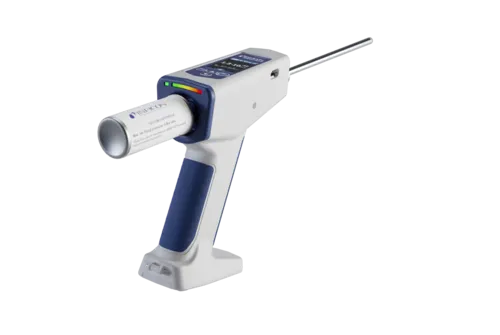
SMART-SPRAY Helium Spray Gun - For UL Equipment
- Portable, wireless helium spray gun
- Flexible and efficient leak testing
- Integrated color display
- Type-C charging replaceable battery

UL6000 Fab Helium Leak Detector - For Large Volumes
- The fastest mobile detector
- Reliable and robust leak detector
- Ideal for the 10⁻⁹ to 10⁻⁸ mbar∙l/s
- Upgrade through email

UL3000 Fab Helium Leak Detector - For Semiconductor
- More efficient with I·CAL software
- Ideal for 10⁻⁹ to 10⁻12 mbar∙l/s
- For vacuum and sniffer leak search
- Easy operator-guided HMI display

UL1000 Fab - Economic Helium Vacuum Leak Testing
- Quick pump down, fast response
- iZERO background suppression
- Well designed for tight spaces
- Low TCO, 3-year warranty

UL1000 Helium Leak Detector - Accurate High Sensitivity
- Wide measure range, fast response
- Mobile maneuverable metal housing
- I-CAL ensures quick leak detection
- Low maintenance, 3-year warranty

Protec P3000(XL) - For Full-time Sniffing Applications
- I-Guide ensures accurate testing
- Compensates for operator errors
- Multiple alarms for timely alerts
- Ergonomic probe, displays leak rate

Modul1000 - Reliable Intelligent Repeatable Platform
- Compact design, easy integration
- Wide detection range, accurate results
- Plug & play, flexible interfaces
- I.STICK for easy data transfer

T-Guard 2 Leak Detection Sensor
- Low operating cost, high uptime
- Test large, warm, or humid objects
- For leaks down to 1×10-6 mbar·l/s
- Flexible control, easy operation

LDS3000AQ Leak Detector - Down to 10-5 mbar l/s
- Cost-efficient, reliable testing
- High accuracy
- Industry 4.0 Fieldbus integration
- Consistent results, temperature, humidity independent

3D Scanner System
- Detects joints by diameter change
- Optimized robot path planning
- Collision and singularity checks
- No robot programming needed
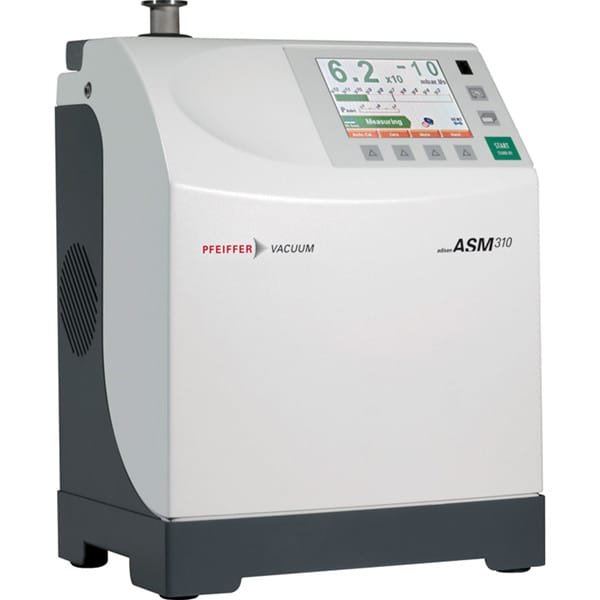
Portable Leak Detectors
Portable leak detectors are small, versatile units that are easily moved to fit in most areas so you can detect leaks without issue.
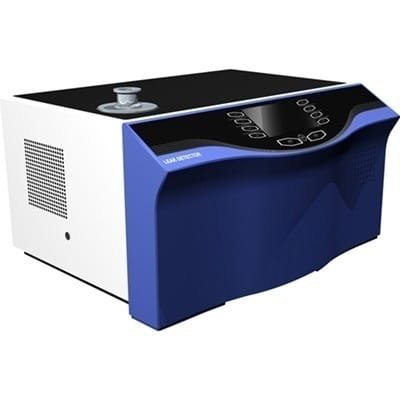
Benchtop Leak Detectors
Benchtop leak detectors are some of the most common leak detectors in industry. They include larger backing pumps over the portable units to help decrease pump down and testing time.
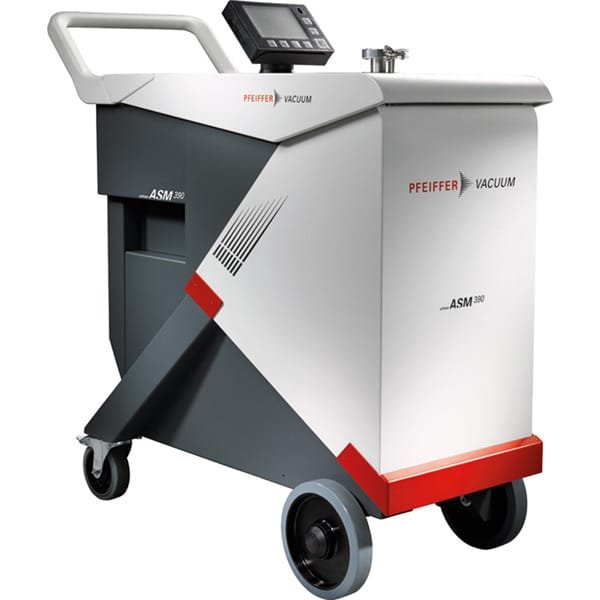
Mobile Leak Detectors
Mobile leak detectors are the largest of the standard leak detectors, including the largest roughing and helium pumping speed available. These units are packaged on wheels for easy transportation from one chamber to another.
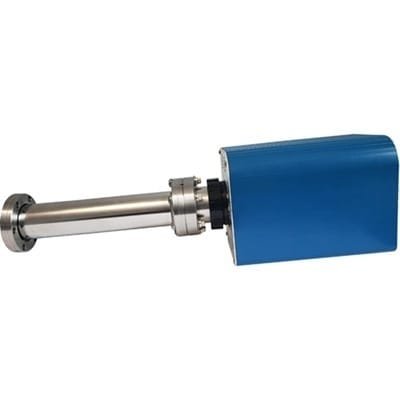
Residual Gas Analyzers (RGA)
- Cost-effective gas analysis
- Faraday Cup and Electron Multiplier options
- 100 and 200 amu options
- 2.6×10-12 Torr Minimum Detectable Partial Pressure (MDPP) with only a Faraday Cup
- Integrated software, LabVIEW drivers, and access to API protocol

HLD Helium Leak Detector Filter
- 10 um proprietary stainless steel media
- KF25 or KF40 ports
- Removeable and cleanable filter
- Compatible with Leak Detectors rated up to 100 m3/hr
The Ultimate Guide to Leak Detectors: Safeguarding Your Home and Business
In today’s world, protecting your property—from residential homes to sprawling industrial complexes—requires proactive monitoring and early warning systems. Leak detectors have emerged as essential devices in preventing water, gas, or other liquid leaks from causing catastrophic damage. This guide will walk you through the inner workings of leak detectors, explain various installation and maintenance strategies, and explore future trends in leak detection technology. Along the way, you’ll find that the most searched keywords—such as Leak Detector, Water Leak Detector, Gas Leak Detector, Smart Leak Sensor, Leak Detection System, Wireless Leak Detector, Pipe Leak Detection, Leak Alarm, Liquid Leak Detection, Leak Monitoring, Leak Detector Installation, and Leak Detector Troubleshooting—are naturally interwoven into the discussion. We will also address common questions like “What is a leak detector?”, “How does a water leak detector work?”, and more within our narrative.
Table of Contents
Chapter 1
Understanding the Basics of Leak Detectors
What Is a Leak Detector?
At its core, a leak detector is a device designed to sense the presence of unwanted water, gas, or other liquids in an environment and alert the user before serious damage occurs. Many readers wonder, “What is a leak detector?” The answer is straightforward: it is a sensor-based system that monitors environmental changes—whether in moisture, chemical composition, or temperature—to signal the presence of a leak. Whether it is a Water Leak Detector under a sink or a Gas Leak Detector in an industrial setting, these devices work by detecting anomalies and then activating a Leak Alarm to warn users.
How Do Water and Gas Leak Detectors Work?
 A common FAQ is, “How does a water leak detector work?” Most water leak detectors utilize moisture sensors that measure electrical conductivity. When water comes into contact with these sensors, it completes an electrical circuit and triggers an alert. Similarly, Gas Leak Detectors use catalytic or semiconductor sensors to identify the presence of combustible gases by detecting changes in the chemical composition of the air. If the concentration of gas surpasses a safe threshold, the device immediately activates an alarm.
A common FAQ is, “How does a water leak detector work?” Most water leak detectors utilize moisture sensors that measure electrical conductivity. When water comes into contact with these sensors, it completes an electrical circuit and triggers an alert. Similarly, Gas Leak Detectors use catalytic or semiconductor sensors to identify the presence of combustible gases by detecting changes in the chemical composition of the air. If the concentration of gas surpasses a safe threshold, the device immediately activates an alarm.
For example, a Smart Leak Sensor not only detects the leak but also communicates the event via Wi-Fi or Bluetooth, integrating with home automation systems for remote monitoring. This connectivity allows homeowners to receive real‑time updates on their smartphones, even when they are away from home.
The Evolution from Basic to Smart Systems
Over time, leak detectors have evolved from simple, standalone alarms to sophisticated systems known as Leak Detection Systems. These modern devices are often Wireless Leak Detectors, eliminating the need for complicated wiring and offering flexibility in installation. They have become integral to both residential and commercial applications, ensuring that any sign of moisture or gas is detected early. For instance, advances in Pipe Leak Detection technologies now allow sensors to pinpoint exactly where a leak is occurring along water pipes, drastically reducing repair times and costs.
Chapter 2
Applications in Residential and Commercial Settings
Residential Protection: More Than Just an Alarm
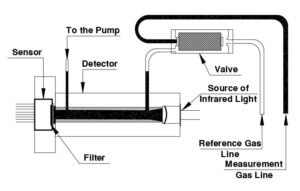 In the home, a leak detector serves as a guardian against unexpected water damage. Homeowners often ask, “Where should I install a leak detector?” The ideal answer is to position these devices in areas where leaks are most likely, such as near water heaters, under sinks, around washing machines, or in basements. The installation of a Liquid Leak Detection system in these strategic areas can prevent costly repairs by providing early warnings before a minor drip turns into a flooding disaster.
In the home, a leak detector serves as a guardian against unexpected water damage. Homeowners often ask, “Where should I install a leak detector?” The ideal answer is to position these devices in areas where leaks are most likely, such as near water heaters, under sinks, around washing machines, or in basements. The installation of a Liquid Leak Detection system in these strategic areas can prevent costly repairs by providing early warnings before a minor drip turns into a flooding disaster.
Consider the scenario of a family using a Water Leak Detector in their basement. One rainy day, a small pipe fracture goes unnoticed until the detector signals an alert. Thanks to the early detection, the family is able to shut off the main water supply and call a professional, preventing what could have become extensive water damage. In doing so, they address the common question, “How can leak detectors save money in the long run?” The answer is clear: by mitigating damage early, you avoid expensive repairs, insurance claims, and the inconveniences associated with major property damage.
Industrial and Commercial Safety
Industrial environments and commercial establishments have even more at stake. In settings such as factories, data centers, and office complexes, a single leak can disrupt operations and cause significant financial loss. Here, comprehensive Leak Monitoring systems are installed to cover large areas with multiple sensors. When a sensor—say, a Gas Leak Detector—picks up unusual levels of gas, it instantly triggers a Leak Alarm and sends alerts to facility managers, often integrated with automated shut-off mechanisms. This addresses a critical question for industrial users: “How reliable are leak detectors in a commercial setting?”
The reliability of these devices comes from robust design and redundancy in sensor networks. With real-time monitoring and data logging, facility managers can quickly pinpoint issues, perform Leak Detector Troubleshooting, and maintain uninterrupted operations. The integration of these systems into larger building management networks ensures that even if one sensor fails, the overall system continues to function effectively.
Chapter 3
Installation and Setup: DIY vs. Professional
Choosing the Right Installation Method
One common inquiry from potential users is, “Do leak detectors require professional installation?” The answer depends on the complexity of the system. Many consumer-grade Leak Detector Installation products are designed for easy DIY setup. Detailed instructions and plug-and-play designs allow homeowners to install the device in key areas without needing technical assistance. However, for larger-scale or integrated systems that cover extensive areas—like those used in commercial facilities—professional installation is highly recommended. This ensures that all sensors are optimally placed and the system is correctly calibrated to avoid false alarms or missed detections.
When planning an installation, it’s also essential to address another FAQ: “Where should I install a leak detector?” For homes, this often means placing the device in basements, near water heaters, under sinks, and around appliances prone to leaks. In commercial installations, sensors might be distributed throughout production lines, storage areas, or around sensitive equipment that could be affected by moisture or gas.
Addressing Concerns of False Alarms
Another frequent question is, “Are leak detectors affected by false alarms?” Some models may indeed trigger alerts due to high humidity, condensation, or dust. Modern Smart Leak Sensors are designed with algorithms that distinguish between normal environmental moisture and actual leaks, thereby reducing false alarms. Proper placement of the detector—such as not directly under a kitchen sink where normal splashing might occur—further minimizes the chance of false notifications.
Chapter 4
Maintenance and Troubleshooting
Routine Maintenance Essentials
To ensure the long-term reliability of any leak detection system, routine maintenance is crucial. This includes periodic checks of the sensors, battery replacement for wireless devices, and regular calibration. A common question that arises is, “What maintenance do leak detectors need?” Routine maintenance involves cleaning the sensor surfaces, testing the alarm system, and ensuring that the device’s firmware is updated if it supports smart connectivity.
For instance, if you have a Wireless Leak Detector, periodic battery checks are vital. If the device fails to send alerts due to low battery, it could lead to delayed responses in the event of a leak. Similarly, for systems integrated into larger networks, regular software updates and system tests help ensure that all components function in unison.
Troubleshooting When Things Go Wrong
Despite their reliability, leak detectors can occasionally malfunction. This leads to another important FAQ: “What should I do if my leak detector alarms?” First, verify whether the alarm is due to an actual leak or a false trigger. If a leak is confirmed, shut off the water or gas supply immediately and contact a professional technician for repairs. If false alarms become frequent, consider adjusting the sensitivity settings or relocating the device.
Another common troubleshooting question is, “How do I choose the best leak detector for my needs?” The answer involves evaluating the type of leak you are most concerned with (water, gas, or liquid), the specific areas where leaks are most likely to occur, and whether you prefer a DIY installation or a professionally installed system. Reading user reviews and industry ratings can provide further insights into reliability and performance.
Chapter 5
The Role of Smart Technology and IoT Integration
Smart Leak Sensors: Beyond Traditional Detection
 Modern leak detectors have come a long way from the basic alarms of the past. With the advent of smart home technology, Smart Leak Sensors are now able to connect to the internet, allowing for remote monitoring via smartphone apps. This connectivity means that users can receive instant alerts wherever they are, ensuring that even if a leak occurs while they’re away, they can act quickly.
Modern leak detectors have come a long way from the basic alarms of the past. With the advent of smart home technology, Smart Leak Sensors are now able to connect to the internet, allowing for remote monitoring via smartphone apps. This connectivity means that users can receive instant alerts wherever they are, ensuring that even if a leak occurs while they’re away, they can act quickly.
For example, imagine being on vacation and receiving a notification from your Leak Detection System about an unexpected drop in water pressure in your home. Thanks to this real-time alert, you can contact someone locally to inspect the situation before it turns into a major problem. This integration of IoT technology into leak detection is a game-changer, enhancing convenience, safety, and overall efficiency.
Predictive Maintenance and Data Analysis
Another fascinating advancement in leak detection technology is the use of data analytics and artificial intelligence. By collecting historical data from multiple sensors, modern systems can not only detect leaks but also predict potential future failures. This capability answers the question, “How do leak detectors help in saving money in the long run?” By identifying vulnerabilities before they result in significant damage, these systems allow for proactive maintenance. This predictive approach not only prevents major incidents but also contributes to lower insurance premiums and reduced repair costs.
Environmental and Sustainability Considerations
Leak detectors also play a critical role in environmental conservation. Early detection of leaks helps conserve water—a precious resource—and prevents the energy waste associated with prolonged leaks. This aspect addresses the broader concern of liquid leak detection in sustainable building practices. By ensuring that water loss is minimized, both homeowners and businesses contribute to overall environmental sustainability and reduced utility bills.
Chapter 6
Real‑World Case Studies and Benefits
Residential Success: Preventing Catastrophic Water Damage
Consider the example of a homeowner who installed a Water Leak Detector near the basement water heater. After noticing a small but persistent drip, the detector promptly sent an alert to the homeowner’s smartphone. This early warning allowed the homeowner to turn off the water supply and contact a plumber before significant damage occurred. This case not only answers the common query, “What should I do if my leak detector alarms?” but also illustrates how a simple device can prevent extensive damage and costly repairs.
Industrial Applications: Enhancing Safety and Operational Efficiency
In a large manufacturing facility, an integrated Leak Detection System was installed to monitor potential leaks in areas with high water and gas usage. When a Gas Leak Detector picked up an abnormal concentration of gas near a critical piece of machinery, the system automatically activated a Leak Alarm and sent alerts to the control center. The facility’s automated safety protocols then shut down the relevant section of the production line, preventing what could have been a dangerous explosion. This incident underscores the importance of comprehensive Leak Monitoring and Pipe Leak Detection in industrial settings, where every second counts.
Cost Savings and Insurance Benefits
By investing in a robust leak detection system, both residential and commercial property owners can experience significant long‑term cost savings. Early detection minimizes water damage, reduces repair expenses, and can even lead to lower insurance premiums. When potential issues are caught early through a smart, integrated system, the return on investment is not merely in safety but also in substantial financial savings over time.
Chapter 7
Future Trends in Leak Detection Technology
Advancements in Sensor Technology
Looking ahead, the field of leak detection is set to benefit from rapid advances in sensor technology. Future Wireless Leak Detectors may feature enhanced sensitivity, lower power consumption, and even self‑calibration capabilities. This means that devices will not only detect leaks with greater precision but also require less frequent maintenance—addressing another common question: “How reliable are leak detectors over time?”
Integration with Broader Home and Industrial Automation
The continued convergence of IoT devices promises a future where leak detectors are an integral part of a fully automated environment. In such a scenario, a Smart Leak Sensor might automatically trigger actions—such as shutting off the main water valve or adjusting ventilation systems—once a leak is detected. The seamless integration with home and industrial automation systems will elevate the role of leak detectors from simple alarms to active participants in property management and emergency response
Enhancing User Experience Through AI
Artificial intelligence and machine learning will further enhance the capabilities of leak detection systems. By analyzing patterns from historical data, future systems could provide predictive analytics that warn users of potential leak risks before they occur. This evolution is set to transform how maintenance is approached, turning reactive responses into proactive management strategies.
Chapter 8
Conclusion: Embracing a Proactive Approach to Safety
Leak detectors have evolved from basic alert mechanisms into sophisticated safety systems that safeguard our homes, businesses, and industrial operations. Whether it’s a Water Leak Detector under the sink, a Gas Leak Detector near industrial equipment, or a Smart Leak Sensor integrated into your home automation network, these devices provide an essential line of defense against the hidden dangers of leaks.
Throughout this article, we’ve seamlessly embedded key terms like Leak Detector, Wireless Leak Detector, Pipe Leak Detection, Leak Alarm, Liquid Leak Detection, Leak Monitoring, Leak Detector Installation, and Leak Detector Troubleshooting into our discussion, ensuring that each concept is thoroughly explored. We also addressed common questions such as:
What is a leak detector?
How does a water leak detector work?
What types of leak detectors are available?
Can leak detectors be integrated into a smart home?
Where should I install a leak detector?
How reliable are leak detectors?
Do leak detectors require professional installation?
What maintenance do leak detectors need?
How can leak detectors save money in the long run?
Are leak detectors affected by false alarms?
What should I do if my leak detector alarms?
How do I choose the best leak detector for my needs?
By providing clear, actionable answers to these FAQs within the context of real-world examples, technical explanations, and future trends, this guide aims to empower property owners and facility managers to make informed decisions.
In summary, investing in a leak detection system is not simply about avoiding emergencies—it’s about embracing a proactive approach to safety, operational efficiency, and sustainability. As technology continues to advance, the capabilities of leak detectors will only grow, ensuring that whether you are protecting your home or a major industrial complex, you are well-equipped to face any challenge.
Taking the time to understand and properly install these systems will lead to improved safety, reduced repair costs, and a more sustainable future. With the integration of modern smart technologies, leak detectors are set to become an indispensable component of comprehensive property management strategies. Now is the time to upgrade your current safety measures and explore the advanced features available in today’s market, ensuring that you—and your property—remain secure in an ever-changing environment.
